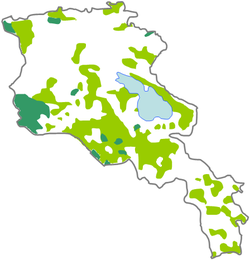Islam in Armenia
Arab invasions and Armenian revolts
Islam by country |
The Muslim Arabs first invaded Armenia in 640. Prince Theodoros Rshtuni led the Armenian defense. In about 652, a peace agreement was made, allowing Armenians freedom of religion. Prince Theodoros traveled to Damascus, where he was recognized by the Arabs as the ruler ofArmenia, Georgia and Albania.[2] By the end of the seventh century, the Caliphate's policy toward Armenia and the Christian faith hardened. Special representatives of the Caliph called ostigans were sent to govern Armenia. The ostigans made the city of Dvin their residence. Before this Dvin had been the residence of the Armenian Catholicos.[2]
Although Armenia was declared the domain of the Caliph, most Armenians, although not all, remained faithful to Christianity. The Arabs failed in several attempts to convert the Armenians to Islam. The Armenian obstinacy exasperated caliph Abd al-Malik. In 705, he gave to one of theostikans an unprecedented order to murder all Armenian Nakharars. More than 400 Armenian noblemen were trapped in one of the Nakhichevan churches; then the doors were closed and the church was set in fire. Later Arab historians termed that time The Year of Great Burning. QuotingPope John VI, "...ocean of tears flooded Armenia". A number of unsuccessful insurrections followed that tragic event during the 8th century.[2]
[edit]The Muslim population and monuments in Armenia
By the turn of the twentieth century, the population of Yerevan, now the capital of Armenia, was over 29,000; of this number 49% were Tatars (Turkic tribes) and Kurds (Muslims), both nomadic and semi-nomadic; 48% were Armenians; and 2% were Russians.[3]According to Brockhaus and Efron Encyclopedic Dictionary, at that time the town of Yerevan had seven Shia mosques. The Blue Mosque is the only one that remains in present day Yerevan. In 1990 a mosque in Yerevan was pulled down with a bulldozer.[4][5] Archaeologist Philip L. Kohl notes the "paucity of surviving Islamic remains in Armenia, including the capital of Yerevan". Citing the information on demography of Armenia before the Russian conquest, Kohl concludes:


Comments
Post a Comment